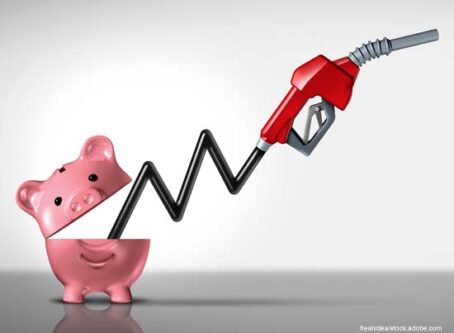South Carolina’s gas tax rebate a lesson in ‘too good to be true’
A recent report by The Post and Courier reveals that the state of South Carolina paid out only $2 million of the allotted $40 million to taxpayers taking advantage of a gas tax rebate. This is not that shocking to me, and I have a feeling this worked as designed by the state.
South Carolina’s gas tax rebate
First, it will help to understand what exactly South Carolina’s fuel tax rebate is all about.
In 2017, the South Carolina legislature passed a bill that would fund infrastructure projects. In order to pay for repairs, maintenance and improvements for transportation, the state government approved a 12-cent gas tax increase. The increase will be phased in by 2-cent increments over six years, which began July 1, 2017.
The bill was not very popular with both voters and the governor. The bill was passed on May 9, 2017, and was immediately vetoed by Gov. Henry McMaster. However, that veto was overridden by the House with a 95-18 vote and the Senate with a 32-12 vote.
Fuel tax increases are rarely popular with the voting public. In order to sell the idea, lawmakers inserted a “rebate” provision to satisfy those with reservations about a gas tax.
Motorists are entitled to a credit on the tax as long as they have evidence of purchase, i.e., receipts.
South Carolina resident taxpayers can apply for another credit for preventative maintenance on passenger vehicles. The credit can be for new tires, oil changes and regular vehicle maintenance.
The idea here is that South Carolina residents won’t actually be paying that additional fuel tax since they can get a tax credit of X amount of cents for every gallon purchased, depending on the tax year. Rather, out-of-state motorists fueling up in South Carolina will be paying into the transportation fund.
It’s a way to legally raid the pockets of out-of-state motorists without breaching the Constitution, in other words. As you will see, it actually screwed most South Carolina motorists as well.
Cheap rebates: Wolf in sheep’s clothing
The first year South Carolina motorists could claim the gas tax credit was 2018. Now that everything has been filed, the numbers for the first year are in.
According to The Post and Courier, only $2 million of the $40 million available for the gas tax rebate was claimed. Approximately, 80,600 tax filers included the rebate. When you average that out, each filer received a whopping $24.
These are the kind of results companies are hoping for when they offer mail-in rebates, which is what the tax credit essentially is.
According to the Federal Trade Commission, mail-in rebates “require consumers to pay the full cost of an item at the time purchased, then send documentation to the manufacturer or retailer to receive a rebate by mail.” In this case, motorists must pay the extra 2 cents per gallon and send proof of that purchase to the government to get a tax credit.
The FTC also notes “documentation required generally includes the original sales receipt, UPC code, rebate slip, and the customer’s name, address and telephone number.” Again, this is exactly what motorists must do when collecting their money.
When it comes to any sort of cash-back incentive, consumers need to know how much they are going to get and how much time they will invest in the so-called rebate or refund.
Like any good deal that sounds too good to be true, there was some fine print in South Carolina’s gas tax rebate. Here’s the “fine print” within the bill that includes the fuel tax rebate:
The total amount of the (preventative maintenance) credit may not exceed the lesser of: (i) the resident taxpayer’s actual motor fuel user fee increase incurred for that motor vehicle as a result of increases in the motor fuel user fee pursuant to Section 12 28 310 …
This means if you do not have preventative maintenance costs to receive credit for, you get nothing.
When applying for the tax credit, motorist must fill out this form, Form I-385. There are four parts to the form:
- Vehicle info.
- Preventative maintenance costs incurred.
- Increase in motor fuel user fee.
- Motor fuel income tax credit computation.
In the fourth part, taxpayers have to take the lesser of parts two and three and multiply that by 0.634 to calculate the credit amount. So if you don’t have your preventative maintenance receipts, you mark part two as zero, which is less than whatever fuel receipts you include in part three. Therefore, you would have to multiply the 0.634 adjustment factor by zero, which is zero.
In addition to keeping every single receipt every time a motorists fuels up at the pump, they also have to keep any receipts for preventative maintenance. This is already a lot more work taxpayers have to do compared to receiving a mail-in rebate for a smartphone.
The media is not oblivious to this idea. A headline from WSPA-TV read “Is the SC gas tax rebate program worth your time?” They used an example of a car that goes 15,000 miles for a year and gets 20 mpg. That car owner will only receive $22.50, and only if the preventative maintenance costs are greater than the fuel costs.
South Carolina’s fuel tax rebate isn’t worth the trouble for most motorists, based on the recent numbers released by South Carolina’s Department of Revenue. A WIS-TV report spent nearly 3,000 words explaining how motorists can receive their small credit. When accounting for time, the return on investment for the rebate is minuscule.
According to a Bloomberg article, “40% of all rebates never get redeemed because consumers fail to apply for them or their applications are rejected.” That same article called rebates a “tax on the disorganized,” as most consumers are either “too lazy, forgetful or busy” to deal with rebates.
It’s worth pointing out that mail-in rebates likely favor the business when the rebate is low. If a rebate is worth hundreds or thousands of dollars, people will do the work. However, the incentive decreases as the rebate value decreases. Is four pages of paperwork worth $24?
Bloomberg also points out a case study. TiVo once reduced its first quarter loss from $9.1 million to $857,000. It was able to do that after 50,000 of 104,000 new subscribers did not redeem their mail-in rebate offer. Consequently, that saved money dramatically reduced TiVo’s expected rebate expense by approximately $5 million.
However, I suspect TiVo knew the projected rebate would be far below 100%, as I suspect South Carolina lawmakers expected the same from their rebate.
In the end, South Carolina sold a bill that would typically fail by offering a rebate that was too much of a hassle to cash in on. And, in the end the state wins big with the vast majority of “rebates” going unclaimed.









